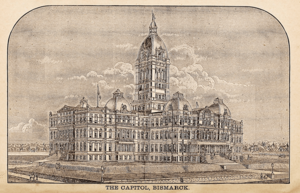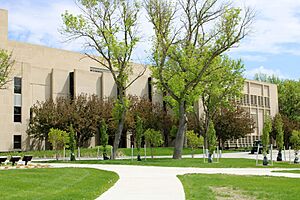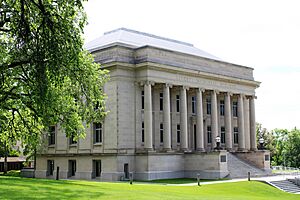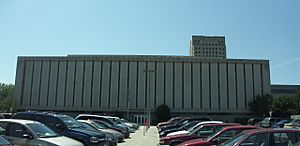North Dakota State Capitol facts for kids
Quick facts for kids North Dakota State Capitol |
|
|---|---|
| Record height | |
| Tallest in North Dakota since 1934 | |
| General information | |
| Architectural style | Art Deco |
| Location | 600 East Boulevard Avenue Bismarck, North Dakota, U.S. |
| Coordinates | 46°49′15″N 100°46′57″W / 46.8208°N 100.7824°W |
| Groundbreaking | 1932 |
| Completed | 1934 |
| Cost | $50 million |
| Height | |
| Tip | 241 ft 8 in (73.66 m) |
| Roof | closed |
| Observatory | 18th floor |
| Technical details | |
| Floor count | 18 |
| Design and construction | |
| Architect | Joseph Bell DeRemer William F. Kurke |
The North Dakota State Capitol is where the government of North Dakota works. This amazing building is a 21-story tower built in the Art Deco style. It is located in Bismarck at 600 East Boulevard Avenue. It is also the tallest building in North Dakota where people live or work.
The Capitol sits on a large campus that is about 160 acres big. Many other government buildings are also on these grounds. The Capitol building and the offices around it are home to the state's law-making and court branches. Many government groups also have their offices here.
The State Capitol is mostly surrounded by other state government buildings. The parks, walking trails, and monuments on the grounds tell a lot about North Dakota's history. This makes it a popular place for visitors in Bismarck. Six buildings are on the grounds, built as the government grew. Some state offices are in other parts of the city. Plans were made in 2000 to make the grounds even bigger, but not much of that plan has happened.
History of the Capitol Building
The first capitol building was built between 1883 and 1884. It was made for the government of the territory before North Dakota became a state. After North Dakota became a state, two more parts were added. These were the Senate wing in 1894 and the House wing around 1903.
On December 28, 1930, smoke was seen coming from the old building. Firefighters arrived quickly, but it was too late to save the structure. Even as the fire burned, people tried to save important items. They were later told to leave the building. It was thought the fire started from oily rags in a janitor's closet. Workers had been cleaning desks for the next meeting of lawmakers.
North Dakota Secretary of State Robert Byrne saved the original copy of the state's constitution. He got cuts and burns on his hands breaking a window to reach it. Another state worker, Jennie Ulsrud, burned her hands trying to save records. Governor George F. Shafer came back from a trip while the fire was still burning. He quickly gathered state leaders to plan how to deal with lost records and office space.
After the fire, 40 state prison inmates helped save vaults and other items from the burned building. Most vaults were still good inside. Lawmakers met in other buildings in Bismarck for a while. State offices were spread out all over town. The lower parts of the old capitol's 1903 wing that did not burn were even fixed and used again.
The fire meant a new building had to be built during the Great Depression. The new tower and wing were built from 1931 to 1934. It cost $2 million. Governor George F. Shafer started the building work on August 13, 1932. Workers were paid only 30 cents an hour. After many worker strikes, the capitol grounds were put under martial law in June 1933. The state sold half of the original capitol land to help pay for the building. Artist Edgar Miller helped with the inside design and sculptures on the outside. These sculptures show the history of North Dakota.
The new 19-story capitol was supposed to have plenty of space for many years. But it quickly filled up as the state government grew. Other buildings were added to the campus over time. The Liberty Memorial Building, finished in 1924, helped house some workers. More space was needed by 1955 when the State Office Building began construction. The state bought this building in 1959.
The 1960s saw many new buildings on the grounds. In 1960, a new governor's home was built. In 1980, the State Historical Society of North Dakota moved into the new North Dakota Heritage Center. In 1968, the North Dakota Department of Transportation moved into its own building. The Transportation Building is the last one built on the campus so far. A Judicial Wing was added to the capitol tower between 1977 and 1981. Even though the government needs more space now, North Dakota's population has gone down since the 1930s.
Capitol Campus Layout
The state capitol grounds have six main buildings. These are the capitol building, the Department of Transportation Building, the North Dakota Heritage Center, the Liberty Memorial Building, the governor's residence, and the State Office Building. There are also two parks: Myron Atkinson Park and Capitol Park.
In the middle of the grounds is the Capitol Mall. This is a large open grassy area with walking paths. These paths are lined with American Elm trees. In 2007, the Mall was the place where North Dakota broke a world record for snow angels. A picture was taken from the top of the Capitol tower of 8,962 people making snow angels.
Buildings on the Campus
State Capitol Building
The capitol building is 241.67 feet tall and has 21 stories. It is an Art Deco high rise building. It was designed by North Dakota architects Joseph Bell DeRemer and William F. Kurke. They worked with a Chicago firm called Holabird and Root. It is the tallest building in North Dakota and is called the Skyscraper on the Prairie.
This tower holds the office of the governor and many state agencies. At the bottom of the tower, in the west wing, the two parts of the legislature meet. The state supreme court meets in the east wing. The 18th floor of the Capitol is an observation deck. It offers the highest view point in the state.
The south side of the Capitol building has a drive-through tunnel. This tunnel leads to an entrance to the building. It was open to public cars until 2001. It was closed for safety after the September 11, 2001, attacks. Now, only people walking can use the tunnel. In 1988, U.S. President George H. W. Bush planted an American Elm tree near the Capitol steps. This was to celebrate North Dakota's 100th birthday in 1989.
The many windows on the capitol building's tower are used for fun traditions. During the Christmas season, red and green shades are pulled over the windows. Lights are turned on in certain offices to make a pattern that looks like a Christmas tree. For New Year's Eve, office lights spell out the new year. The first two numbers are on the top half, and the last two numbers are on the bottom. This tradition started in the 1970s and is now done on all four sides of the building. The Christmas tree tradition began in the 1940s.
You can take tours of the capitol building on weekdays. Weekend tours are available from Memorial Day through Labor Day. Tours include visits to the legislative and judicial wings. You also get an elevator ride to the top of the tower.
Judicial Wing
The judicial wing is home to the state supreme court and its staff. It also has offices for state groups like the Department of Health. The building was designed starting in May 1977. Construction began in April 1979 and it was finished by 1981. The Judicial Wing is 168,400 square feet and cost $10.5 million. The building was officially opened on November 15, 1981. Both Governor Allen Olson and former Governor Arthur A. Link were there. This wing also has the Capitol lunchroom. It serves food to state workers and the public on weekdays.
Before the 2017 Legislative Assembly, two new committee rooms were added in the Judicial Wing. These rooms are used by different legislative committees when lawmakers are meeting. They are used by the court system when the Legislature is not meeting.
Liberty Memorial Building
The Liberty Memorial Building houses the State Library. It also has offices for the North Dakota Parks & Recreation Department. Lawmakers approved building it in 1919 because the government was growing. It was finished by 1924 and cost $350,000. This building first held the State Historical Society Museum and the supreme court. Later, the State Library moved in. It is the oldest building still on the capitol grounds. It was updated in 1982 to meet modern building rules.
Department of Transportation Building
The North Dakota Department of Transportation Building is where the state's transportation department has its main office. It also has small parts of other groups. The building was finished in 1968. Its materials match the look of the older buildings. Before this building, the Department of Transportation was in several other buildings on campus. This included the State Office Building and the capitol itself. The building has 125,000 square feet of space. It is just east of the capitol tower. While it looks separate above ground, it is connected to the Judicial Wing by a tunnel. Only state employees can use this tunnel.
North Dakota Heritage Center
The North Dakota Heritage Center building is home to a museum. This museum keeps and shows items from all over the state. The building also has offices for the North Dakota State Historical Society. This group runs the museum. Planning for the building started in 1963. When it was finished in 1981, the State Historical Society moved in. The building has 130,000 square feet. It has areas for exhibits, storage, meeting rooms, and offices.
In 2006, state officials announced a big plan to make the center much larger. The construction cost about $50 million. It almost doubled the size of the complex. Three large galleries were added to the east. A new main entrance facing State Street was also built. The original building was 140,000 square feet, and the expansion added 125,000 square feet. Money for the project came from private donations, federal funds, and state funds.
Besides new gallery space, the expansion includes a 50-seat digital auditorium. It also has climate-controlled storage areas, a café, and a children's gallery. There are also expanded visitor services and a store. The Corridor of History is a 25-foot-wide walkway. It runs the length of the new part. One side has large windows, and the other has digital murals.
State Office Building
The State Office Building is on the southeast corner of the campus. It holds the Water Commission. It also has parts of the office of the Attorney General. These include the Civil Litigation Division and attorneys for Natural Resources and Indian Affairs. Built in 1955, the building was home to Bismarck Junior College until 1961. That is when lawmakers approved buying it. Since then, it has housed different state agencies. Between 1991 and 1993, the building was greatly updated. Its outside was changed to match the other buildings on the campus better. At 28,838 square feet, it is the smallest office building on the grounds.
North Dakota Governor's Residence
Before 1960, North Dakota's First Family lived in a house away from the capitol grounds. In 1960, the state built a new home near 4th Street on the west side of the campus. This replaced the old house. In 2000, the residence was greatly updated. It had more than 10,000 square feet of space and eighteen rooms.
In 2015, lawmakers approved a new residence next to the old one. This new home would be better for safety and access. The state offered the old house to anyone who would move it, but no one wanted to. So, it was torn down. The new home was expected to cost $5 million. $1 million of that was to come from private donations. The governor's family moved into the new residence in March 2018.
Outdoor Areas
Parks
Two parks are on the capitol grounds: Myron Atkinson Park and Capitol Park. Myron Atkinson Park is east of State Street. It is named after a Bismarck lawyer, Myron Atkinson. People can get to the park through a tunnel. Capitol Park is at the northwest corner of the grounds. It is at the crossing of 4th Street and Divide Avenue. It has a playground with trees and bushes planted by the Farwest Rotary Club.
Arboretum Trail
The Arboretum Trail is a walking path. It winds through a wooded area on the west side of the grounds. Walkers can see 60-million-year-old petrified tree stumps from the Amidon, North Dakota, area. There are also 75 different kinds of trees and bushes. These are labeled with signs on the ground. Various statues and memorials are also on the trail. The trail was made in 1985 to get ready for the state's 100th birthday. It also gave state workers and the public a place to exercise and learn about trees and the history of the buildings. Many schools bring students here for nature walks. Students used to collect leaves from the trees. This damaged some trees, so signs were put up to stop leaf picking.
Prairie Trail
The Prairie Trail runs north of the Capitol's Judicial Wing. It takes people into an area with examples of grasses and wild flowers. These plants are typical of native prairie. In 2006, the trail was made longer. It now takes walkers from the corner of State Street and Divide Avenue south into the main grounds. The original trail was dedicated with a plaque in 1987. The wild grassland around the trail was named a state Natural Area by the Parks and Recreation Department.
Statues and Other Features
Statues
Several statues are on the grounds. They show Sakakawea (1910), a pioneer family (1946), John Burke (1963), a bison (1986), "Pioneers of the Future" (1989), and an Arabian horse (1994).
Memorials
The grounds have memorials for members of the armed forces from North Dakota. These honor those who died in the state's first century. There are also memorials for police officers who died while on duty, and Purple Heart recipients. North Dakota's French Gratitude Train car is also on the grounds. You can also see the front part of the USS North Dakota ship.
Fossils
60-million-year-old fossilized Metasequoia trees from Amidon, North Dakota were placed on the grounds in 1988.
Former Landmarks
A Mandan earth lodge used to be on the grounds. It was removed because it was decaying. A cabin belonging to Teddy Roosevelt was moved to Medora, North Dakota.
See also
 In Spanish: Capitolio del Estado de Dakota del Norte para niños
In Spanish: Capitolio del Estado de Dakota del Norte para niños
- List of North Dakota Legislative Assemblies
- List of tallest buildings by U.S. state
- List of state and territorial capitols in the United States






